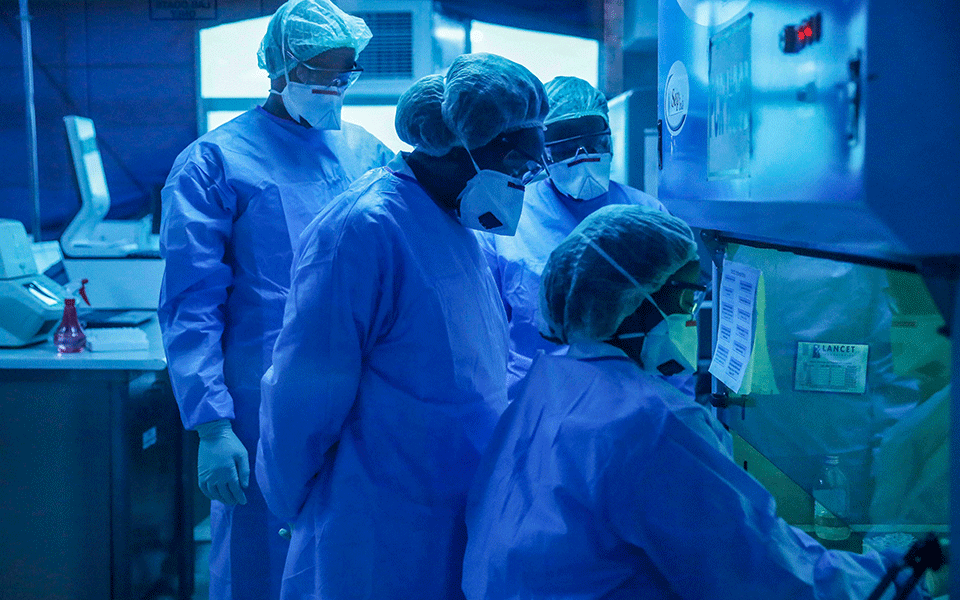New York: Scientists have found the first compelling evidence that two groups of ecologically important marine microorganisms could be eating viruses -- catching their "prey" and engulfing them, an advance that may lead to a better understanding of the flow of organic matter in the oceans.
The findings, published in the journal Frontiers in Microbiology, go against the currently predominant views of the role of both viruses and these groups of single-celled organisms called protists in the marine food webs.
"Our data show that many protist cells contain DNA of a wide variety of non-infectious viruses but not bacteria, strong evidence that they are feeding on viruses rather than on bacteria," said study corresponding author Ramunas Stepanauskas, Director of the Single Cell Genomics Center at Bigelow Laboratory for Ocean Sciences in the US.
The scientists explained that the predominant model of the role of viruses in the marine ecosystem is that of the "viral shunt," where microbes infected with viruses lose a substantial fraction of their chemicals back to the pool of dissolved organic matter.
However, the current study noted that the viral shunt could be complemented by a link in the marine microbial food web which may constitute a "sink of viral particles in the ocean."
According to the researchers, this finding "has implications for the flow of carbon through the microbial food web."
In the study, Stepanauskas and his colleagues sampled surface seawater from the Northwestern Atlantic in the Gulf of Maine in the US in July 2009, and the Mediterranean off Catalonia, Spain in January and July 2016.
They used modern single-cell genomics tools to sequence the total DNA from 1,698 individual protists in the water, and found evidence of protists with or without associated DNA.
The researchers explained that the associated DNA could be from symbiotic organisms, ingested prey, or viruses or bacteria sticking to the protists' exterior.
While the technique is very sensitive, the scientists said it doesn't directly show the type of relationship between a protist and its associates.
The scientists found a range of protists including groups called alveolates, stramenopiles, chlorophytes, cercozoans, picozoans, and choanozoans.
They said 19 per cent of the genome from the single cell organisms taken from the Gulf of Maine and 48 per cent of those from the Mediterranean were associated with bacterial DNA, suggesting that these protists had eaten bacteria.
But they added that viral sequences were more common, making up 51 per cent of the protists' genome from the Gulf of Maine and 35 per cent of those from the Mediterranean, with a frequency of one to 52 virus types per protist.
According to the researchers, most of these were from viruses known to infect bacteria -- presumably representing parasites of the protists' bacterial prey.
But they said choanozoans and picozoans, which only occurred in the Gulf of Maine sample, were different since these groups, neither of which have chloroplasts, are poorly known.
The scientists noted that the choanozoans are of great evolutionary interest as the closest living relatives of animals and fungi.
The tiny single-celled organisms were first discovered twenty years ago, and until now, their food sources were a puzzle, as their feeding apparatus is too small for bacteria, but ample for viruses, the researchers said.
In the current research, they found that every single one of the choanozoan and picozoan genomes were associated with viral sequences from bacteria-eating viruses called phages, but mostly without any bacterial DNA.
The same genome sequences were found across a great diversity of species, the study noted.
"It is very unlikely that these viruses are capable of infecting all the protists in which they were found," said Julia Brown, a co-author of the study at the Bigelow Laboratory for Ocean Sciences.
Based on these findings, the scientists concluded that choanozoans and picozoans "probably routinely eat viruses."
"Viruses are rich in phosphorus and nitrogen, and could potentially be a good supplement to a carbon-rich diet that might include cellular prey or carbon-rich marine colloids," Brown said.
The scientists believe the removal of viruses from the water may reduce the number of viruses available to infect other organisms, while also shuttling the organic carbon within virus particles higher up the food chain.
"Future research might consider whether protists that consume viruses accumulate DNA sequences from their viral prey within their own genomes, or consider how they might protect themselves from infection," Brown said.
Let the Truth be known. If you read VB and like VB, please be a VB Supporter and Help us deliver the Truth to one and all.
Amritsar (PTI): Former president Ram Nath Kovind on Friday said that with digital transformation, economic reforms and a strong focus on the ease of doing business, India is moving towards becoming a global economic powerhouse.
He was speaking after inaugurating the 19th edition of the Punjab International Trade Expo (PITEX) in Amritsar.
The former president said that this 19th edition of PITEX is being organised at a time when India is recognised as one of the fastest-growing large economies in the world.
Speaking at the inaugural ceremony of the event organised by the PHD Chamber of Commerce and Industry (PHDCCI) the former president, while referring to Punjab, said the state is a living example of courage, sacrifice and enterprise.
"The spiritual light of Sri Harmandir Sahib (Golden Temple) inspires peace and humanity across the world. The heritage of Punjab is deep and inspiring," Kovind said, according to a statement issued by the PITEX.
The former president congratulated the PHDCCI for hosting the 19th edition of PITEX and suggested that the chamber should expand PITEX outside Punjab.
He proposed that a similar event should also be held in New Delhi.


_vb_69.jpeg)


